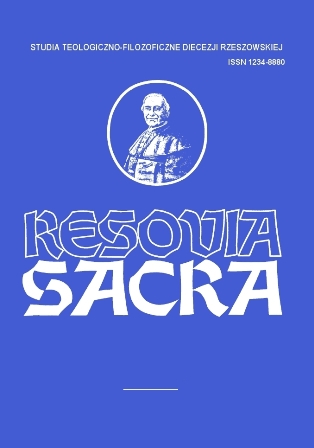Ku syntezie hipotez dotyczących tożsamości proroka Ozeasza: część I
In Search of the Idenfity or Prophet Hosea
Author(s): Jan Maria Chun Yean ChoongSubject(s): Christian Theology and Religion, Theology and Religion, Biblical studies
Published by: Instytut Teologiczno-Pastoralny im. św. Józefa Sebastiana Pelczara w Rzeszowie
Summary/Abstract: Prophet Hosea is in many ways extraordinary. Ranked as the first amongst Minor Prophets, Hosea was one of the very few early writing prophets. Despite being unknown beyond his own book, Hosea’s theological thinking had, in a sense, revolutionised the way Israelites perceived God. The most renown is perhaps his marriage metaphor, which had later been deployed by other prophets like Deutero-Isaiah, Jeremiah as well as Ezekiel. Throughout centuries much valuable work had been done on the Book of Hosea that amplifies the enigma of Hosea’s true identity. Various biblical analyses reveal that Hosea was a very well educated man speaking a language full of metaphors and emotions. He was the only one amongst all early writing prophets who used Yahweh’s self-revelation formula in his book. There was none like Hosea in the Old Testament who had gone so far in vocation as to take a prostitute as wife, let alone giving his own children shameless names. He was well informed on various topics: not only the history and geography of his own nation, the northern kingdom – Israel, but also the political life inside and out of the royal palace. Furthermore, his insider knowledge on cultic matters, his criticism and accusation on priests for neglecting their duties, his alternative programme of religious reform based upon specific criteria: true knowledge of God coupled with the conversion of heart force us to ask one simple, but profound and fundamental, question: “Who could Hosea be”? Scholars had put forward various propositions. Some say that Hosea could have been a priest and a Levite. Others, however, see Hosea as a baker. Yet some others propose that Hosea’s root is of Benjamin/Ephraim and that he was a farmer. The debate continues and the riddle remains unsolved. Despite the availability of rich materials concerning the prophet’s identity, they are, however, scattered apart and “buried” deeply in different commentaries and scholarly papers. There is currently no literature available solely dedicated to analyse the problem of Hosea’s identity per se, gathering all existing hypotheses in one and presenting them in a synthetic way. Neither is it available in Poland, nor in the wider English speaking world. This paper represents such an attempt. However, due to the vast amount of materials at hand this paper is separated into two parts. The first part presents a synthesis of all hypotheses except the one that postulate Hosea as a Levipriest. The latter will be reated in the second installment of the paper.
Journal: Resovia Sacra. Studia Teologiczno-Filozoficzne Diecezji Rzeszowskiej
- Issue Year: 2010
- Issue No: 17
- Page Range: 5-25
- Page Count: 21
- Language: Polish

